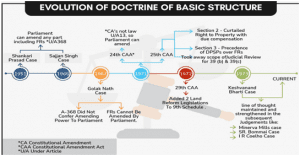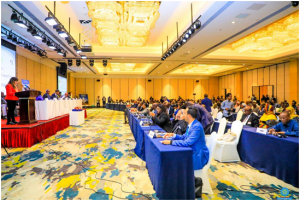Table of Contents
1. BASIC STRUCTURE DOCTRINE
TAG: GS 1: POLITY
THE CONTEXT: The debate, which had raised great passions in 1951 during the discussion on the First Amendment of the Constitution has now been revived by the assertion of Previous CJI that the “Basic Structure Doctrine” has “a very debatable jurisprudential basis”.
EXPLANATION:
What is the basic structure doctrine?
- The Doctrine of Basic Structure is a form of judicial review that is used to test the legality of any legislation by the courts.
- The doctrine was evolved by the Supreme Court in the 1973 landmark ruling in Kesavananda Bharati v State of Kerala. In a 7-6 verdict, a 13-judge Constitution Bench ruled that the ‘basic structure’ of the Constitution is inviolable, and could not be amended by Parliament.
- There is no exclusive and definitive list of what the basic features are, for the judiciary decides this on a case-by-case basis.
- The test is widely regarded as a check on majoritarian impulses of the Parliament since it places substantive limits on the power to amend the Constitution.

Elements of the basic structure
- Parliament under Article 368 can amend any part of the Constitution including the Fundamental Rights but without affecting the ‘basic structure’ of the Constitution.
- However, the Supreme Court is yet to define or clarify as to what constitutes the ‘basic structure’ of the Constitution.
- From the various judgements, the following have emerged as ‘basic features’ of the Constitution or elements / components / ingredients of the ‘basic structure’ of the constitution:
- Supremacy of the Constitution
- Sovereign, democratic and republican nature of the Indian polity
- Secular character of the Constitution
- Separation of powers between the legislature, the executive and the judiciary
- Federal character of the Constitution
- Unity and integrity of the nation
- Welfare state (socio-economic justice)
- Judicial review
- Freedom and dignity of the individual
- Parliamentary system
- Rule of law
- Harmony and balance between Fundamental Rights and Directive Principles
- Principle of equality
- Free and fair elections
- Independence of Judiciary
- Limited power of Parliament to amend the Constitution
- Effective access to justice
- Principles (or essence) underlying fundamental rights.
- Powers of the Supreme Court under Articles 32, 136, 141 and 142
- Powers of the High Courts under Articles 226 and 227
2. CHOKUWA RICE
TAG: GS 1: ART AND CULTURE
THE CONTEXT: Chokuwa rice recently earned a GI (Geographical Indication) tag for its exquisiteness.
EXPLANATION:
- Chokuwa rice ,also known as magic rice is a part of Assam culinary heritage, this unique rice has been a staple of the troops of the mighty Ahom dynasty.
- This unique and healthy rice is cultivated around the Brahmaputra area and is cultivated in several parts of Assam like Tinsukia, Dhemaji, Dibrugarh, Lakhimpur, Sivasagar, Jorhat, Golaghat, Nagaon, Morigaon etc.
- Chokuwa rice is basically a semi-glutinous winter rice also known as Sali rice. The sticky and glutinous variety is categorized as Bora and Chokuwa based on their amylose concentration.
- The low amylose Chokuwa rice variants are used to make soft rice, which is known as Komal Chaul or soft rice.

- This whole grain can be consumed after soaking the rice in the cold or lukewarm water.
- For the uninitated, this rice is pre-boiled, dried, then stored and soaked right before consumption.
- This rice variety is widely consumed for its convenience of preparation and nutritional value.
- This unique rice variety is consumed with curd, sugar, jaggery, bananas to name a few. This rice is also used in making several Assamese delights like Pithe and other local dishes.
NOTE: Refer to 2nd August DNA for more information on Geographical Indication tag.
3. NATIONAL PHARMACEUTICAL PRICING AUTHORITY (NPPA)
TAG: GS 2: SOCIAL JUSTICE; GOVERNANCE
THE CONTEXT: The National Pharmaceutical Pricing Authority (NPPA) has brought 44 new drugs under price control. These drugs are commonly used for pain management, depression, anxiety, gastro- related ailments, hypertension and several auto-immune diseases.
EXPLANATION:
- The move is aimed to make these drugs cheaper. Manufacturers failing to comply with the price cap have to return the overcharged amount to the government.
- Retail price for various drugs as paroxetine controlled release and clonazepam, a combination drug used for treating mood swings and anxiety and Itraconazole capsule, used to treat fungal infections, has been fixed.
- Other drugs as metformin and sitagliptin combination, used to treat high blood sugar levels caused by type 2 diabetes and Chlorthalidone, amlodipine and telmisartan tablets, a combination used in the treatment of high blood pressure has been fixed.
- The manufacturers not complying with the regulations shall be liable to deposit the overcharged amount as per the provisions of the Drugs (Prices Control) Order, 2013 and Essential Commodities Act 1955.
National Pharmaceutical Pricing Authority
- National Pharmaceutical Pricing Authority was established as an attached office of the Department of Pharmaceuticals.
- It is in charge of controlling medicine pricing in the nation and ensuring that they are accessible, affordable, and readily available to all of the nation’s citizens.
- The NPPA was set up in 1997 to fix/revise prices of controlled bulk drugs and formulations and to enforce price and availability of the medicines in the country, under the Drugs (Prices Control) Order, 1995-2013.
Functions of National Pharmaceutical Pricing Authority (NPPA):
- Utilizing the authority granted to it, administer and enforce the requirements of the Drugs Price Control Order (DPCO), 1995/2013.
- To carry out and/or support pertinent studies about the cost of medications/formulations.
- To gather and retain information on manufacturing, exports, and imports, individual company market shares, business profitability, etc. for bulk pharmaceuticals and formulation.
- To handle all legal issues resulting from the Authority’s judgments.
- To provide guidance to the central government on modifying or updating the drug policy.
Essential Commodities Act 1955:
- The Act gives powers to the central government to add or remove a commodity in the “Schedule.” The Centre, if it is satisfied that it is necessary to do so in public interest, can notify an item as essential, in consultation with state governments.
- At present, the “Schedule” contains 9 commodities — drugs; fertilisers, whether inorganic, organic or mixed; foodstuffs, including edible oils; hank yarn made wholly from cotton; petroleum and petroleum products; raw jute and jute textiles; seeds of food-crops and seeds of fruits and vegetables, seeds of cattle fodder, jute seed, cotton seed; face masks; and hand sanitisers.
- By declaring a commodity as essential, the government can control the production, supply, and distribution of that commodity, and impose a stock limit.
4. ADDIS ABABA DECLARATION
TAG: GS 3: ECOLOGY AND ENVIRONMENT
THE CONTEXT: Environment ministers of the African continent have agreed to institute national and regional strategies to minimise environmental impacts in the extraction and processing of critical mineral resources.
EXPLANATION:
- The continent is facing several challenges as countries, especially China, rush to Africa for its mineral resources.
- Fifty-four countries acknowledged key environmental challenges faced by the continent land degradation, desertification, and drought in the Addis Ababa declaration.

The 19th session African Ministerial Conference on the Environment (AMCEN) was held at Addis Ababa from August 14-18, 2023.
Addis Ababa Declaration 2023:
- 19th African Ministerial Conference on the Environment (AMCEN) 2023 held from August 14 to 18, 2023 at Addis Ababa, Ethiopia.
- The theme for AMCEN 2023 was “Seizing Opportunities and Enhancing Collaboration to Address Environmental Challenges in Africa”.
- Addis Ababa declaration was signed by 54 nations and acknowledge challenges of land degradation, desertification and drought.
- The declaration focus was urgent, wide-ranging action on environmental challenges related to climate change, plastics pollution, marine protection, biodiversity conservation and natural capital.
- The countries also committed to take appropriate measures to implement the Kunming-Montreal Global Biodiversity Framework through updating or revising national biodiversity strategies and action plans or national targets.
- The Goal of the declaration is to increase the global finance flow to at least $100 billion per year.
- Countries agreed to work on a priority to implement the Africa Blue Economy Strategy of the African Union.
Africa Blue Economy Strategy of the African Union:
- The African Union (AU) published the Africa Blue Economy Strategy in 2018 because the continent’s BE could be a generator of jobs and livelihoods for millions of current and future generations.
- The objective of the BE Strategy is to guide the development of an inclusive and sustainable blue economy that becomes a significant contributor to continental transformation and growth.
- It is done through advancing knowledge on marine and aquatic biotechnology, environmental sustainability, the exploitation and beneficiation of deep-sea mineral and other resources
5. CLIMATE ACTION TO PROTECT CHILDREN’S RIGHTS
TAG: GS 3: ECOLOGY AND ENVIRONMENT
THE CONTEXT: The United Nations released a new guidance “General Comment No. 26” on children’s rights and the environment, with a particular focus on climate change.
EXPLANATION:
- It provides a legal framework to address the adverse effects of environmental degradation and climate change on the enjoyment of children’s rights and to ensure a clean, healthy, and sustainable world and to preserve it for future generation.
- The recognition is legally significant as it details member states’ obligations under the Child Rights Convention to address environmental harms and guarantee that children can exercise their rights.
NEW GUIDELINES:
- In the new guidelines, the UN member states have been asked to take all necessary, appropriate, and reasonable measures to protect against harms to children’s rights related to climate change that are caused by businesses.
- Nations have been urged to equitably phase out the use of coal, oil and natural gas.
- They have also been asked to ensure a fair and just transition of energy sources and invest in renewable energy, energy storage and energy efficiency to address the climate crisis.
- Establishing inclusive early warning systems must be a priority of all the nations to protect children from impacts of the extreme weather events.
- It has also urged upon the developed countries to provide grants rather than loans for actions to avoid negative impacts on children’s rights.
- It has voiced its concerns over the unequal share of finances provided for adaptation and loss and damage measure.
OTHER REPORTS OR CONVENTION:
- In 1989, the UN convention on rights of the child outlined children’s rights, which includes the right to life, health, clean drinking water and survival and development. It has been ratified by 196 countries.
- As per research of UNICEF, all of the world’s 2.02 billion children are expected to be exposed to high heatwave frequency, regardless of whether the world achieves a low greenhouse gas emission scenario by 2050.
- Reducing carbon emissions can prevent 4,000 to 6,000 child deaths due to heat in Africa every year, according to a study. Extreme weather events around the world displaced at least 12 million children in 2022, as per the UNICEF estimates.

